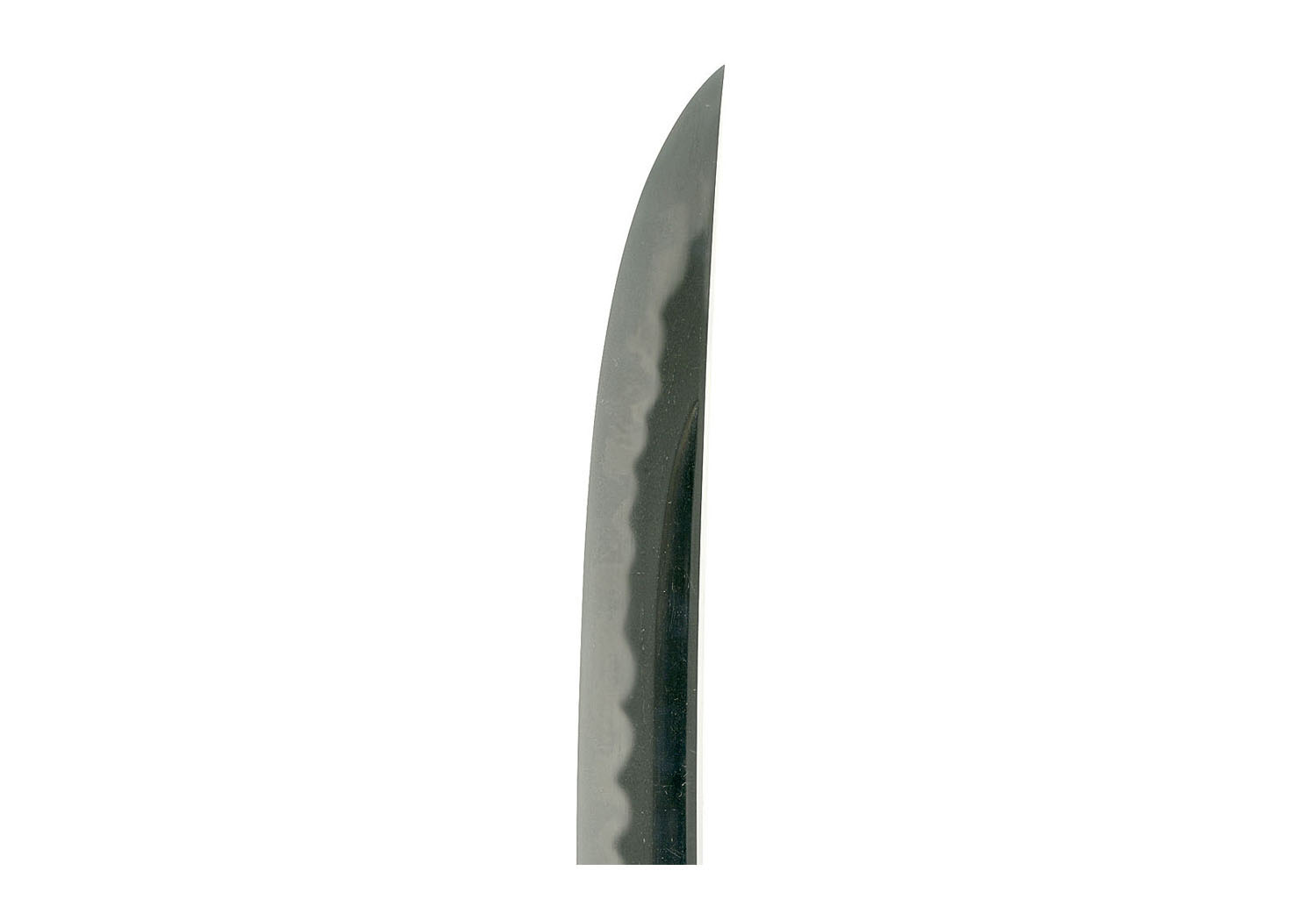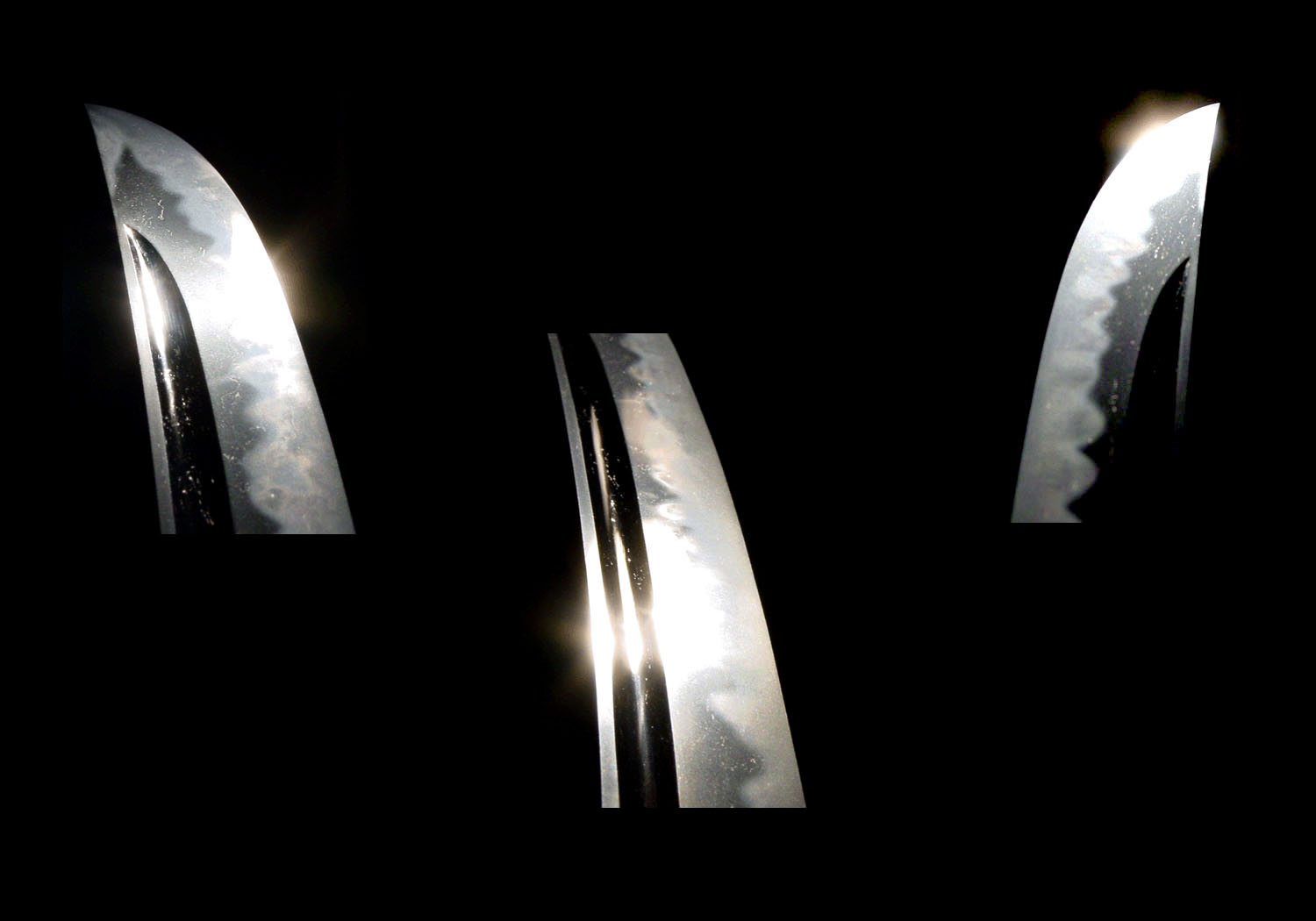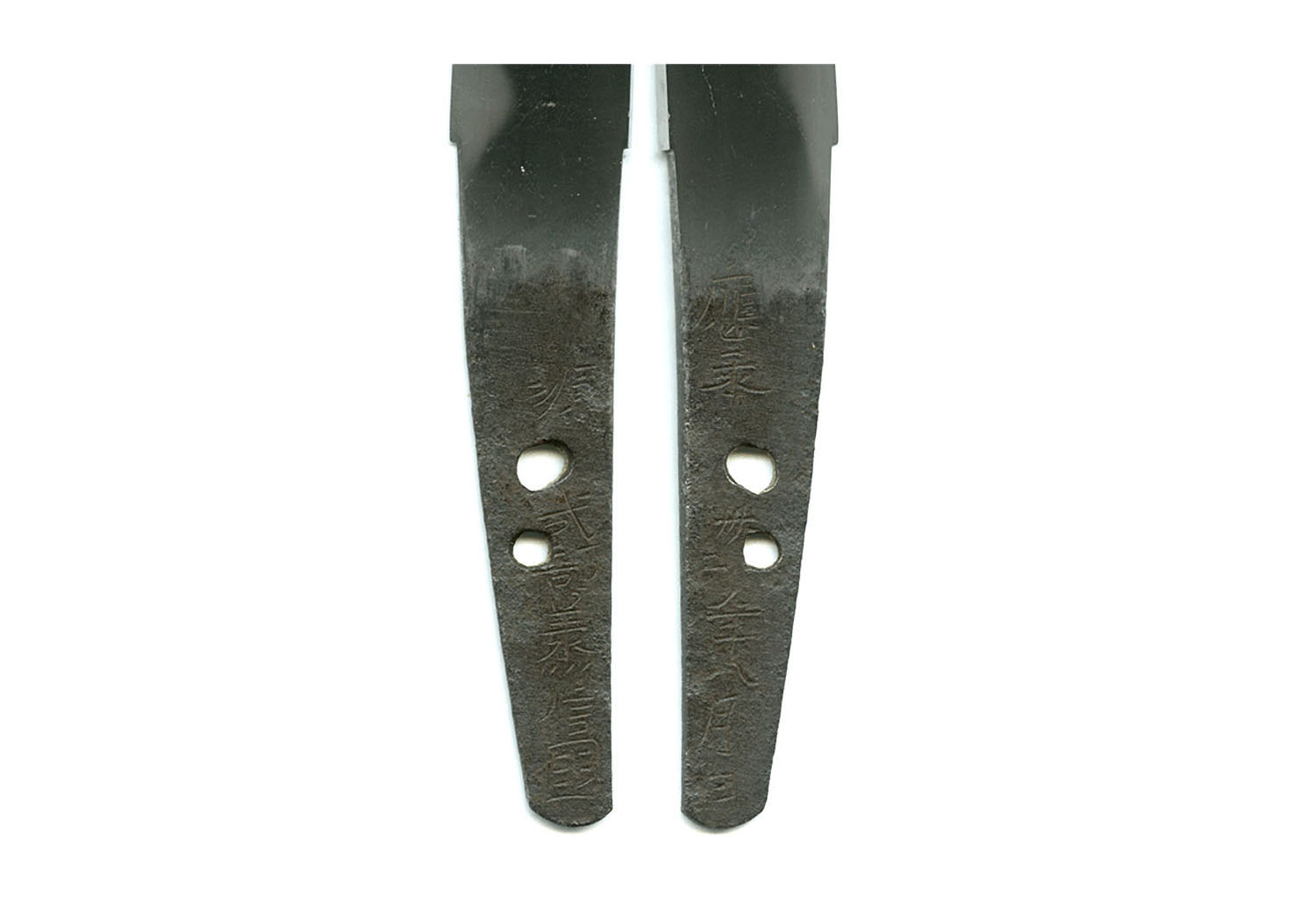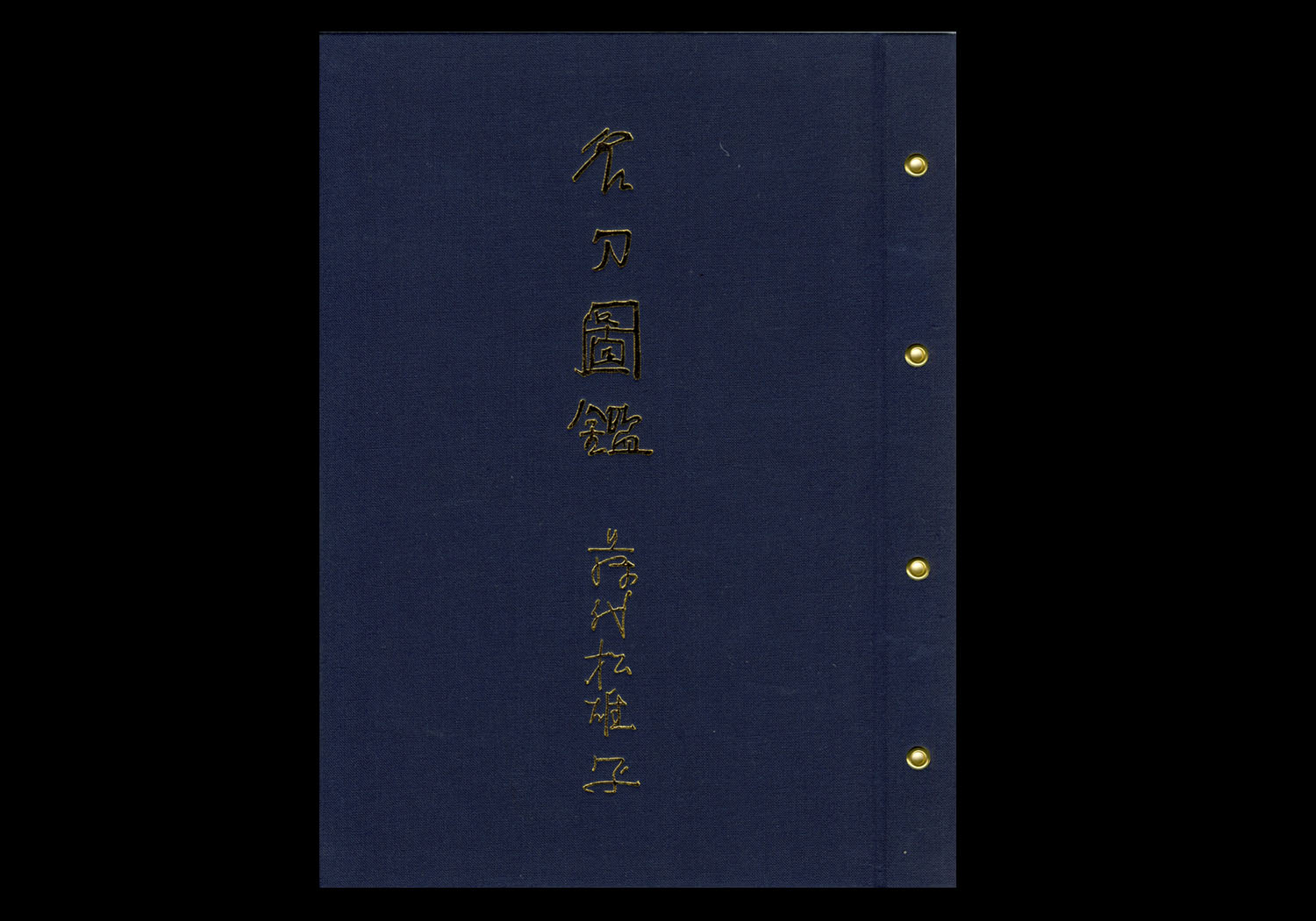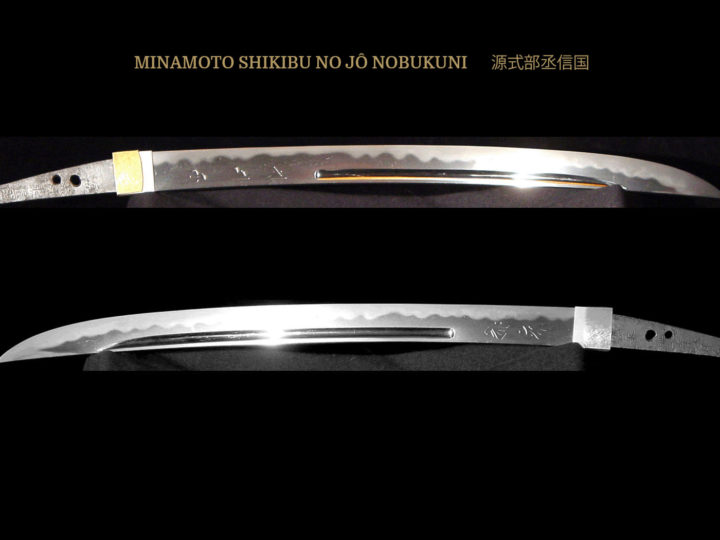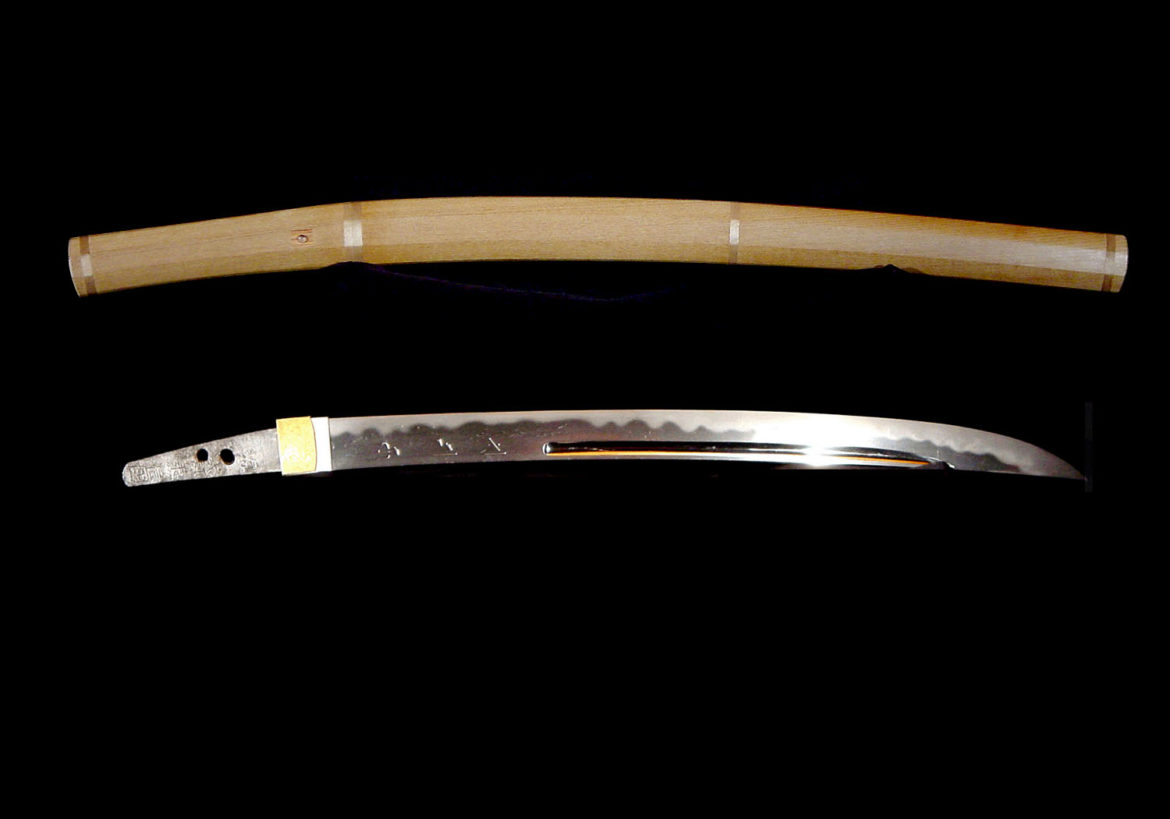
The first generation Nobukuni was from Yamashiro Province. He was the son of Ryokai Hisanobu and he is thought to have been one of the three great students of Soshu Sadamune (Sadamune San Tetsu). He was active in the early to mid 1300’s. He is classified as both a Yamashiro smith and a Soshu smith in the various references. Since his working style was Soshu rather than Yamashiro, we will classify him as a Soshu smith.
The second generation Nobukuni made blades in the middle of the 1300’s while the third generation of smiths by this name worked in the last decade of the 1300’s through about 1430 (the Oei era). Following the third generation in the Oei era there were two Nobukuni smiths of high repute. The first was Minamoto Saemon no Jo (or Genzaemon no Jo) Nobukuni and the second was Minamoto Shikibu no Jo Nobukuni. The second of these two smiths, Shikibu-no-jo Nobukuni made the blade offered for sale here.
The third generation Nobukuni and the successive generations of smiths by this name, who worked well into the Oei era, had a unique style of hamon composition making the kantei of his blades relatively easy to distinguish from the first two generations. Their gunome often forms the so-called yahazu-gokoro patterns (shaped like arrow notches) consisting of two similar gunome placed next to each other. Further, the yahazu-gokoro hamon includes a short or low-headed gunome in between them, making this the key kantei point of the hamon of these particular Nobukuni smiths. Such patterns may regularly be found along the length of the hamon , or in some works they can only be seen in certain areas along the edge. If they are present, however, they definitely point to one of the later generations of Nobukuni as being the smith in question.
The generations of smiths named Nobukuni that followed the third generation are generally referred to as the Oei Nobukuni. While there were several smiths of this name and most never reached the quality of the first three generations, there were two smiths among them, however, that do stand out as far as superior workmanship is concerned. The first was Minamoto Saemon no Jo (or Genzaemon no Jo) Nobukuni and the second was Minamoto Shikibu no Jo Nobukuni. Both of these smiths left wonderful blades but their skill never reached the zenith of that of the first two generations. Also since they made blades well into the Muromachi era, the overall shape and style of their blades make it possible to easily distinguish between them and the first two generations.
The second of these two smiths is Shikibu no Jo Nobukuni. He is said to have been the younger brother of Genzaemon Nobukuni. He signed with the two-character signature, Nobukuni and he also signed with his given name of Shikibu no Jo Nobukuni. He also included the honorific title Minamoto in his signature thus giving him his full signature of Minamoto Shikibu no Jo Nobukuni. His skill was equal to that of his brother and, as with all of the Nobukuni smiths, he was a skillful horimono carver.
The fabulous blade being offered here is a Juyo Token wakizashi by Shikibu no Jo Nobukuni. It is dated as being made in the 32nd year of Oei or 1425. The following is the translation of the Juyo Token zufu of this sword:
Designated Juyo Token at the 23rd Shinsa of July First, the 50th year of Showa (1975)
Wakizashi, Signature: Minamoto Shikibunojo Nobukuni; Oei sanjuni-nen hachi-gatsu (a day in the 8th month, the 32nd year of Oei, 1425)
Measurements: Length: 44.0 cent.; Curvature: 0.8 cent.; Width at Base: 2.95 cent.; Nakago Length: 11.5 cent.; Nakago Curvature: slight.
Characteristics: The construction is hira-zukuri with a mitsu-mune. The blade is wide and long with slight curvature. The kitae is itame-hada that is covered in ji-nie. The hamon is gunome-midare with a mixing in of ko-notare-ba. There is yo activity and the habuchi is covered in ko-nie. There are streaks of sunagashi. The boshi is midare-komi with a slightly pointed tip and a kaeri. There are katana-hi and bonji carved on both side of the blade. The nakago is ubu, and the yasurime are katte-sagari. There are two mekugi-ana, and on the sashi-omote near the mune is a large sized six-character signature, and there is a date in the same area on the ura.
Explanation: This is a wakizashi by Shikibunojo Nobukuni, who is the representative Oei Nobukuni. Shikibunojo Nobukuni is said to be the younger brother of Minamoto Saemonnojo, and this is valid if Nobumitsu and Minamoto Saemon are the same smiths and Nobusada and Shikibunojo are the same smiths; however, if they are different smiths, then the works with Nobukuni signatures are, at the most, earlier works by Shikibunojo, or, at the least, slightly later by Shikibunojo. The relationship between these two smiths is something that requires further research from now on.
The signature on this wakizashi has “Minamoto” at the top, and thus we know that it is used as a surname just like the “Minamoto” with Saemon.
This work clearly displays the characteristics of Shikibunojo Nobukuni in the gunome-midare with its powerful nie covering and in the jiha.
PRICE: $47,750.00
JÛYÔ TÔKEN KANTEISHO
From the Meito Zukan, Vol. 25 (Illustrated Record of Famous Swords), dated March of 1990 and by Fujishiro Matsuo.
The above page shows two blades by this smith, Shikibu-no-jo Nobukuni. The subject blade is the blade on the left. Here is a translation of the write-up on this blade by Fujishiro:
Shikibunojo Nobukuni (Yamashiro Province)
Wakizashi; Signature: Minamoto Shikibunojo Nobukuni; Oei sanjuni-nen san-gatsu hi (a day in the 3rd month, the 32nd year of Oei, 1425).
The length is one shaku, four sun and six bu, and the sori is three bu. The kitae is itame. The hamon is gunome intertwined with midare-ba that has a lot of variations; however, it is similar to the hamon on the right side blade. On the omote is carved a bohi with three bonji, and on the ura is carved a bohi with two bonji. Shikibunojo Nobukuni is the son of Saemonnojo Nobukuni, and the interior of the “kuni” character is like that on the right side blade. There is a wakizashi by Shikibunojo Nobukuni dedicated to the Fuji Asama Shrine, and it is signed Ichigo Hitokoshi (a sword for a lifetime) and dated a day in the second month, the 34th year of Oei (1427). There are a great many works dated to around this time, and his late period of activity reached into the Eikyo era (1429-1441).



